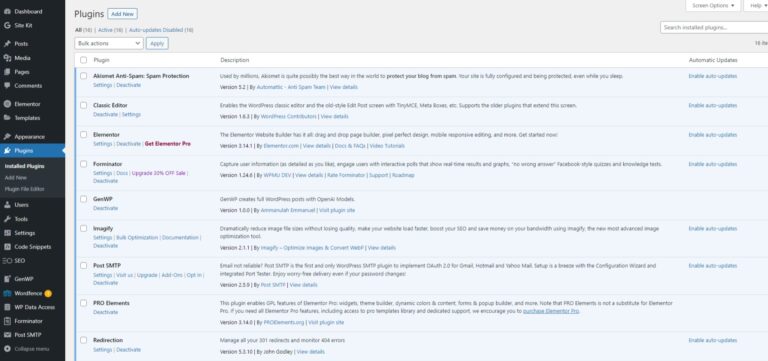WordPress is one of the world’s most popular content management systems (CMS), powering millions of websites. One of the reasons for its popularity is the vast array of plugins that extend its functionality. If you’re a developer looking to create your own WordPress plugins, you’ll need the right tools to streamline your development process and ensure high-quality results. This article explores some of the best WordPress plugin development tools to help you create powerful and efficient plugins.
1. Integrated Development Environments (IDEs)
An IDE is an essential tool for any developer, and when it comes to WordPress plugin development, a few IDEs stand out from the rest.
1.1 Visual Studio Code
Visual Studio Code (VS Code) is a lightweight yet powerful IDE developed by Microsoft. It offers excellent support for various programming languages, including PHP, used for WordPress plugin development. With its extensive library of extensions, VS Code can be customized to suit your needs as a plugin developer.
Here are some key features of Visual Studio Code:
- IntelliSense: VS Code provides intelligent code completion and suggestions as you type, making it easier to write error-free code.
- Git Integration: The built-in Git integration allows you to manage version control directly within the IDE.
- Debugging: VS Code offers a robust debugging experience with breakpoints, variable inspection, and more.
- Extensions: There are numerous extensions available for WordPress development that enhance productivity and provide additional features.
1.2 PhpStorm
PhpStorm is another popular IDE among WordPress developers. Developed by JetBrains, PhpStorm offers advanced features tailored explicitly for PHP development.
Key features of PhpStorm include:
- Code Analysis: PhpStorm provides comprehensive code analysis capabilities that help identify errors and improve code quality.
- Refactoring Tools: The IDE offers powerful tools that allow you to rename variables and extract methods more efficiently.
- Database Tools: PhpStorm includes built-in tools enabling seamless integration with your WordPress database.
- WordPress-specific Features: PhpStorm offers specific features for WordPress development, such as support for WordPress hooks and functions.
2. Local Development Environments
Setting up a local development environment is crucial for efficient plugin development. It allows you to test your plugins in a controlled environment before deploying them to a live website. Here are two popular local development environments for WordPress:
2.1 Local by Flywheel
Local by Flywheel is a user-friendly local development tool specifically designed for WordPress. It simplifies setting up a local environment and provides an intuitive interface for managing your WordPress sites.
Key features of Local by Flywheel include:
- One-click WordPress Installation: Setting up a new WordPress site is as easy as clicking a button.
- SSL Support: Local by Flywheel automatically generates SSL certificates, allowing you to develop secure plugins.
- Accessible Site Cloning: You can quickly clone existing sites to create multiple instances for testing different plugin versions or configurations.
- Live Link: With the Live Link feature, you can share your local site with clients or team members for feedback without deploying it to a live server.
2.2 Docker
Docker is an open-source platform that allows you to automate the deployment of applications inside containers. It provides a lightweight, portable environment that can be easily replicated across different machines.
Key benefits of using Docker for WordPress plugin development:
- Isolation: Each plugin can be developed in its container, ensuring that dependencies and configurations do not interfere.
- Portability: Docker containers can be easily shared and deployed on different machines without worrying about compatibility issues.
- Scalability: Docker allows you to scale your development environment effortlessly by adding or removing containers as needed.
- Version Control: Docker images can be versioned, allowing you to track changes and roll back to previous versions if necessary.
3. Plugin Development Frameworks
A plugin development framework can significantly speed up the development process by providing a foundation of reusable code and predefined structures. Here are two popular frameworks for WordPress plugin development:
3.1 Plugin Boilerplate
Plugin Boilerplate is a standardized set of files and code snippets that serve as a starting point for developing WordPress plugins. It follows best practices and coding standards, making it easier to maintain and collaborate on projects.
Key features of Plugin Boilerplate include:
- Modular Structure: The boilerplate encourages a modular approach, allowing you to organize your code into separate files for better maintainability.
- Action and Filter Hooks: Plugin Boilerplate provides predefined action and filter hooks that make extending your plugin’s functionality easy.
- Localization Support: The boilerplate includes internationalization support, making translating your plugin into different languages more accessible.
- Unit Testing: Plugin Boilerplate comes with built-in unit testing support using PHPUnit, ensuring the quality of your code.
3.2 WordPress Plugin Framework (WPPF)
WordPress Plugin Framework (WPPF) is a comprehensive framework that provides an object-oriented approach to WordPress plugin development. It offers many features and utilities that simplify everyday tasks and promote code reusability.
Key features of WPPF include:
- MVC Architecture: WPPF follows the Model-View-Controller (MVC) architectural pattern, making it easier to separate concerns and maintain clean code.
- Database Abstraction Layer: WPPF includes a robust database abstraction layer that simplifies database operations within your plugins.
- Form Builder: The framework provides a form builder class, allowing you to easily create complex forms with validation and error handling.
- Caching: WPPF includes caching mechanisms that can improve the performance of your plugins by reducing database queries.
Conclusion
Developing WordPress plugins can be a rewarding experience, but it requires the right tools to ensure efficiency and quality. Integrated development environments like Visual Studio Code and PhpStorm provide potent writing and debugging code features. Local development environments such as Local by Flywheel and Docker allow you to test your plugins in a controlled environment before deployment. Plugin development frameworks like Plugin Boilerplate and WordPress Plugin Framework (WPPF) provide a solid foundation for building robust and maintainable plugins.
By leveraging these best WordPress plugin development tools, you can streamline your workflow, improve code quality, and create powerful plugins that enhance the functionality of WordPress websites. So explore these tools and take your WordPress plugin development skills to the next level!


